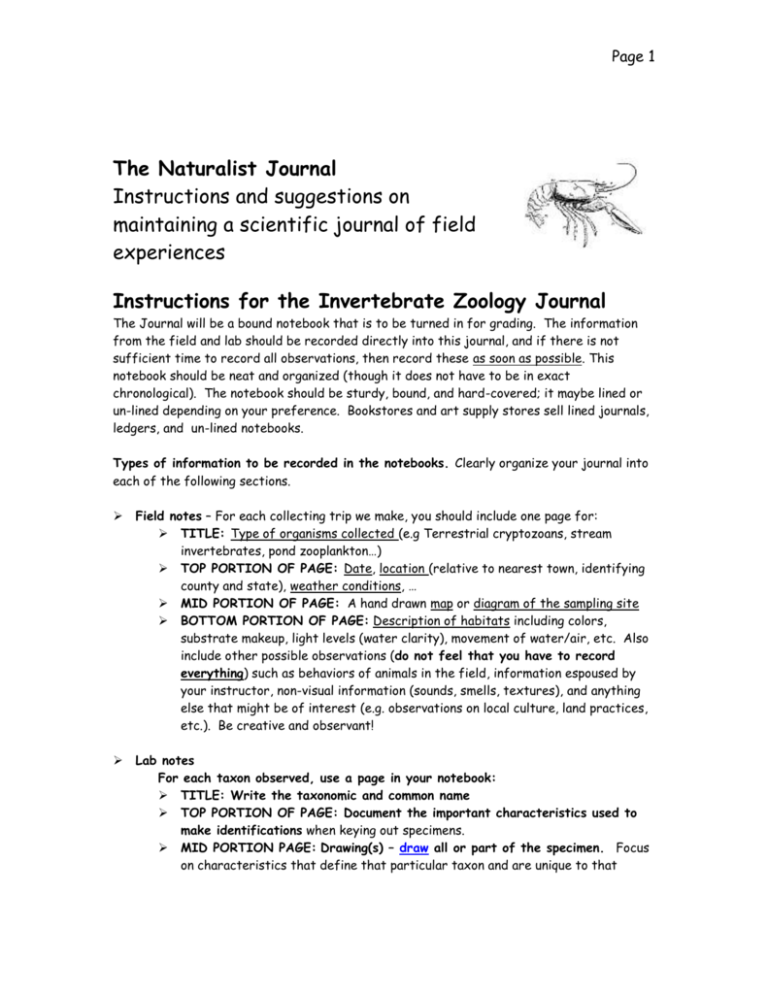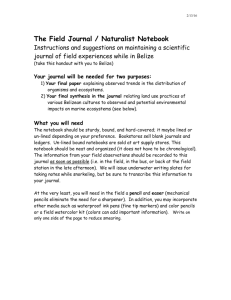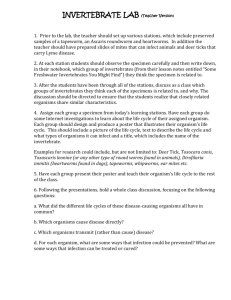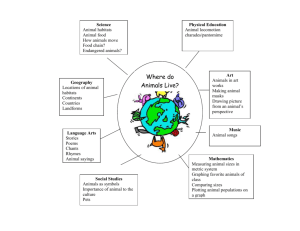Instructions for Aquatic Biodiversity Notebooks
advertisement

Page 1 The Naturalist Journal Instructions and suggestions on maintaining a scientific journal of field experiences Instructions for the Invertebrate Zoology Journal The Journal will be a bound notebook that is to be turned in for grading. The information from the field and lab should be recorded directly into this journal, and if there is not sufficient time to record all observations, then record these as soon as possible. This notebook should be neat and organized (though it does not have to be in exact chronological). The notebook should be sturdy, bound, and hard-covered; it maybe lined or un-lined depending on your preference. Bookstores and art supply stores sell lined journals, ledgers, and un-lined notebooks. Types of information to be recorded in the notebooks. Clearly organize your journal into each of the following sections. Field notes – For each collecting trip we make, you should include one page for: TITLE: Type of organisms collected (e.g Terrestrial cryptozoans, stream invertebrates, pond zooplankton…) TOP PORTION OF PAGE: Date, location (relative to nearest town, identifying county and state), weather conditions, … MID PORTION OF PAGE: A hand drawn map or diagram of the sampling site BOTTOM PORTION OF PAGE: Description of habitats including colors, substrate makeup, light levels (water clarity), movement of water/air, etc. Also include other possible observations (do not feel that you have to record everything) such as behaviors of animals in the field, information espoused by your instructor, non-visual information (sounds, smells, textures), and anything else that might be of interest (e.g. observations on local culture, land practices, etc.). Be creative and observant! Lab notes For each taxon observed, use a page in your notebook: TITLE: Write the taxonomic and common name TOP PORTION OF PAGE: Document the important characteristics used to make identifications when keying out specimens. MID PORTION PAGE: Drawing(s) – draw all or part of the specimen. Focus on characteristics that define that particular taxon and are unique to that Page 2 specimen. You might draw a close up of any adaptation that might help explain why that organism is successful in that habitat. BOTTOM PORTION OF PAGE: In addition to characteristics that were used to key out the specimen, also note other characteristics that you observed on that particular specimen. For each specimen include notes on: o Coloration o Size (e.g. 2X, 4 cm, or a line indicating actual size) o At least one unusual or notable anatomical structure (think about what might be useful to an organism living in the particular environment from which it was collected). o Other observations if possible (e.g. texture, behavior if alive, …) Provide a short synthesis of information on a separate page for each lab period. For example: What is your general overall impression of this group of organisms? How could any observed structures and behaviors be explained by the environment/habitat from which the organisms were collected? How do the taxa collected in one environment compare with those from another habitat or site? Don’t be afraid to speculate. You may also include questions that arise from your observations but are not immediately answerable from the data at hand. Before turning your journals in at the end of the semester, include a “Final Synthesis Section” that will include a few pages comparing and contrasting adaptations of invertebrates from the different habitats that we collected from. 1) Identify general trend in the differences among invertebrates collected in different habitats You should make at least three of comparisons of organisms among the various habitats sampled. For example: Marine vs. Freshwater Aquatic vs. Terrestrial Planktonic vs. Benthic Cryptozoan vs. Non-cryptozoan Macro-cryptozoan vs. Micro-cryptozoan Lentic benthic (pond) vs. Lotic benthic (Stamp Creek) Temporary pool vs. permanent pond or any other habitat comparison you wish to make For each comparison, you should identify at least two traits that tend to be different among the habitats. Here are some examples of traits that you might consider in your comparisons: Pigmentation Symmetry Method of locomotion (or lack of it as in sessile attached organisms) Body proportions and size Segmentation Page 3 Body form Outer covering Feeding mode: active versus passive (suspension feeding) Method of locomotion Stage of life that dispersal occurs Overall diversity of the assemblage Taxonomic representation (e.g. did one phylum or class seem particularly well represented?) Look back in your journal at your drawing and notes to find inspiration. Note that not all organisms in a given habitat are going to share a particular trait. However, some traits do occur more often in some habitats relative to others. 2) Use specific examples from your lab journal as qualitative data to provide evidence for the trends you identify. For example, if you are arguing that many of cryptozoans were bioluminescent, then say, “ two kinds of dipterans and one oligochaete that we collected under logs and rocks glowed when first observed”. 3) Relate your observed trends in morphology and lifestyle to the environment from which organisms were collected. Speculate on how differences in habitat might explain the differences in morphology and lifestyle that you noted above. Specifically consider how habitats differ for example in buoyancy of the medium, movement of the medium, light levels, the backgrounds against which the organisms live, stability and predictability of habitats, connectivity of habitats, etc., and explain how these any of these aspects of the environment may have lead to the evolution of at least one of the character differences you noted in each of the three comparisons. You should use both written descriptions and drawings, though the degree to which you use either will depend on whether you prefer expressing information in written form or more graphically. Feel free to be artistic with such things as page layouts and lettering. Criteria used in grading notebooks Your journal may end up anywhere along a three-way continuum from the ‘scientific’ record, to the ‘artistic’ journal, to the ‘literary’ book. That is your decision and it is likely that the journal will evolve as the semester progresses (and hopefully though out your career). If your drawings are not detailed, then your written descriptions need to be more detailed. However, regardless of your finished product it must contain relevant scientific information both in pictures and writings. Specifically the journals will be graded for: 15 pts - Completeness, accuracy, neatness, organization, and clarity (show me you made an effort). This includes number of identifications documented in lab - you Page 4 will only be marked off for this if you have significantly fewer ID's than others in the class; in other words, you will need to spend the entire two hours in lab. 15 pts - Observation ability – i.e. your notes should not only include characteristics that were used to key out the specimen, but also other characteristics that you observed (and may be unique to that species). Make some original observations. 20 pts - Synthesis of observations and thoughts. Not only should you provide a short synthesis of information on a separate page for each lab period, but also the final entry in your journal should be your “Final Synthesis Section”. Due Date – see lab schedule in syllabus There will be a 5% deduction per 24 hours after the due date! Page 5 Why keep a journal? The goal of the journal is to help you develop a broader understanding of the natural history of invertebrates. ‘Natural history’ requires extensive observation as its raw material and yields meaningful and expansive synthesis as a final product. For centuries the naturalist’s journal has been a tool to accomplish this goal. Benefits of keeping a field journal include: increasing powers of observation (“It would take a lifetime to explore your own backyard”; Brown 1983) improving retention of experiences Noss (1996) states that “scientific abstraction and fancy technologies are no substitutes for the wisdom that springs from knowing the world and its creatures in intimate, loving detail”. documenting observations for future reference by yourself and by others (An old Chinese proverb states that the palest ink is better than the best memory) (Thomas Jefferson commanded Lewis and Clark to keep journals and make multiple copies in case of loss, and he instructed that their observations ” be taken with great pain and accuracy” (Herman 1980)). providing opportunity to be creative and to use skills from other disciplines providing opportunity to synthesize your observations and to integrate this synthesis with your knowledge from other fields of biology and from other disciplines outside of biology. Over the last century, disciplines within science have become more splintered and specialized, where researchers obtain the bulk of their observations from narrowly focused publications. Throughout this trend in specialization, the importance and preservation of the naturalist approach has continued to be advocated (e.g. Noss 1996). In technical work a man of this age must specialize, but in a reconnaissance of a part of the earth’s face, whether soil or sea, I want my comprehension, like that of Charles Darwin, to be able to interpret the underlying significance of clouds, hailstones, argillaceous rock, hot springs, cacti, land planarians, ice-bourne boulders, carrion beetles, wingless flies, graminivourous birds, nest-building fish, viviparious reptiles, dodders, omnivourous rodents, sessile-eyed crustaceans, insect-eating plants, and foraminiferous protozoans!” Robert Cushman Murphy, in Logbook for Grace (1947), from a journal on a voyage to the Antarctic in 1912 (Herman, 1980) Why draw and write? Drawings are extremely useful even if you have no artistic ability. Drawing enhances observation and retention. To draw requires attention to both detail and overall composition. The tactile act of transferring this to paper forces one to use different sets of neural pathways that enhance the learning experience (kinesthetic learning). An organism or landscape drawn re-enforces a memory far better than does snapping a photograph. In addition, drawing captures large amounts of information (the old cliché ‘ a picture is worth a thousand words’). An example might be a simple sketch of topography that might otherwise be difficult to describe in few words. A quick sketch of key morphological characteristics of an unidentified organism is often useful upon return where more reference materials and keys are available, particularly if the organism is not collected or if key characteristics are lost in preservation. Page 6 Like drawing, writing (paragraphs with complete sentences) allows you to use additional parts of your brain. One must re-live the experience when writing, improving retention. People who study how humans learn suggest that most of us don’t learn effectively from experience alone. In order to learn from our experiences we have to do something to help make sense of them. Writing is a particularly effective way to make an experience our own and to learn from it. Much of our thinking and communicating is, after all, through language. Writing typically requires association of the experience with past experiences and knowledge, providing opportunity for synthesis. You will find that new thoughts occur to you as you write your notes. Further, the field experience and writing of one day can become the raw material for even more significant insights, when you have many such days. Literature Cited Brown, T. 1983. Tom Brown’s Field Guide to Nature Observation and Tracking. The Berkley Publishing Group, New York. Herman SG. 1980. The Naturalist’s Field Journal: A Manual of Instruction Based on a System Established by Joseph Grinnell. Noss RF. 1996. “The naturalists are dying off”. Conservation Biology 10:1-3.










